Weakening Investigation of Reservoir Rock by Coupled Uniaxial Compression, Computed Tomography and Digital Image Correlation Methods: A Case Study
Abstract
1. Introduction
2. Sample Preparation and Test Methods
2.1. Sample Preparation
2.2. Test Methods
2.2.1. Cyclic Wetting and Drying Test
2.2.2. Uniaxial Compressive Test
2.2.3. CT Test
2.2.4. DIC Test
3. Results
3.1. Strength Variation
3.2. Structure Variation
4. Conclusions
Author Contributions
Funding
Institutional Review Board Statement
Informed Consent Statement
Data Availability Statement
Acknowledgments
Conflicts of Interest
References
- Li, C.; Fu, Z.; Wang, Y.; Tang, H.; Yan, J.; Gong, W.; Yao, W.; Criss, R.E. Susceptibility of reservoir-induced landslides and strategies for increasing the slope stability in the Three Gorges Reservoir Area: Zigui Basin as an example. Eng. Geol. 2019, 261, 105279. [Google Scholar] [CrossRef]
- Tang, H.; Wasowski, J.; Juang, C.H. Geohazards in the three Gorges Reservoir Area, China–Lessons learned from decades of research. Eng. Geol. 2019, 261, 105267. [Google Scholar] [CrossRef]
- Zou, Z.; Lu, S.; Wang, F.; Tang, H.; Hu, X.; Tan, Q.; Yuan, Y. Application of Well Drainage on Treating Seepage-Induced Reservoir Landslides. Int. J. Environ. Res. Public Health 2020, 17, 6030. [Google Scholar] [CrossRef] [PubMed]
- Shen, P.; Tang, H.; Huang, L.; Wang, D. Experimental study of slaking properties of red-bed mudstones from the Three Gorges Reservoir area. Mar. Georesour. Geotechnol. 2019, 37, 891–901. [Google Scholar] [CrossRef]
- Yao, W.; Li, C.; Zhan, H.; Zhou, J.Q.; Criss, R.E.; Xiong, S.; Jiang, X. Multiscale Study of Physical and Mechanical Properties of Sandstone in Three Gorges Reservoir Region Subjected to Cyclic Wetting-Drying of Yangtze River Water. Rock Mech. Rock Eng. 2020, 53, 2215–2231. [Google Scholar] [CrossRef]
- Su, X.; Tang, H.; Huang, L.; Shen, P.; Xia, D. The role of pH in red-stratum mudstone disintegration in the Three Gorges reservoir area, China, and the associated micromechanisms. Eng. Geol. 2020, 279, 105873. [Google Scholar] [CrossRef]
- Ulusay, R. The ISRM Suggested Methods for Rock Characterization, Testing and Monitoring: 2007–2014; Springer: Cham, Switzerland, 2014. [Google Scholar]
- Zhang, Q.B.; Zhao, J. A review of dynamic experimental techniques and mechanical behaviour of rock materials. Rock Mech. Rock Eng. 2014, 47, 1411–1478. [Google Scholar] [CrossRef]
- Dong, L.; Zhang, Y.; Ma, J. Micro-crack mechanism in the fracture evolution of saturated granite and enlightenment to the precursors of instability. Sensors 2020, 20, 4595. [Google Scholar] [CrossRef]
- Wu, Q.; Jiang, Y.; Tang, H.; Luo, H.; Wang, X.; Kang, J.; Zhang, S.; Yi, X.; Fan, L. Experimental and Numerical Studies on the Evolution of Shear Behaviour and Damage of Natural Discontinuities at the Interface Between Different Rock Types. Rock Mech. Rock Eng. 2020, 53, 3721–3744. [Google Scholar] [CrossRef]
- Zou, Z.; Zhang, Q.; Xiong, C.; Tang, H.; Fan, L.; Xie, F.; Yan, J.; Luo, Y. In Situ Shear Test for Revealing the Mechanical Properties of the Gravelly Slip Zone Soil. Sensors 2020, 20, 6531. [Google Scholar] [CrossRef]
- Hounsfield, G.N. Computerized transverse axial scanning (tomography): Part 1. Description of system. Br. J. Radiol. 1973, 46, 1016–1022. [Google Scholar] [CrossRef] [PubMed]
- Brenner, D.J.; Hall, E.J. Computed tomography-an increasing source of radiation exposure. N. Engl. J. Med. 2007, 357, 2277–2284. [Google Scholar] [CrossRef] [PubMed]
- Buzug, T.M. Computed tomography. In Springer Handbook of Medical Technology; Springer: Berlin/Heidelberg, Germany, 2011. [Google Scholar]
- Abrams, H.L.; McNeil, B.J. Medical implications of computed tomography (CAT scanning). N. Engl. J. Med. 1978, 298, 255–261. [Google Scholar] [CrossRef] [PubMed]
- Hounsfield, G.N. Computed medical imaging. Science 1980, 210, 22–28. [Google Scholar] [CrossRef]
- Hiriyannaiah, H.P. X-ray computed tomography for medical imaging. IEEE Signal Process. Mag. 1997, 14, 42–59. [Google Scholar] [CrossRef]
- Rao, P.M.; Rhea, J.T.; Novelline, R.A.; Mostafavi, A.A.; McCabe, C.J. Effect of computed tomography of the appendix on treatment of patients and use of hospital resources. N. Engl. J. Med. 1998, 338, 141–146. [Google Scholar] [CrossRef] [PubMed]
- Johns, R.A.; Steude, J.S.; Castanier, L.M.; Roberts, P.V. Nondestructive measurements of fracture aperture in crystalline rock cores using X ray computed tomography. J. Geophys. Res. Solid Earth 1993, 98, 1889–1900. [Google Scholar] [CrossRef]
- Mees, F.; Swennen, R.; Van Geet, M.; Jacobs, P. Applications of X-ray computed tomography in the geosciences. Geol. Soc. 2003, 215, 1–6. [Google Scholar] [CrossRef]
- Taud, H.; Martinez-Angeles, R.; Parrot, J.F.; Hernandez-Escobedo, L. Porosity estimation method by X-ray computed tomography. J. Pet. Sci. Eng. 2005, 47, 209–217. [Google Scholar] [CrossRef]
- Yun, T.S.; Jeong, Y.J.; Kim, K.Y.; Min, K.B. Evaluation of rock anisotropy using 3D X-ray computed tomography. Eng. Geol. 2013, 163, 11–19. [Google Scholar] [CrossRef]
- Yang, E.; Yun, T.S.; Kim, K.Y.; Moon, S.W.; Seo, Y.S. Estimation of the Structural and Geomechanical Anisotropy in Fault Gouges Using 3D Micro-Computed Tomography (μ-CT). Sensors 2020, 20, 4706. [Google Scholar] [CrossRef] [PubMed]
- Kim, H.; Diaz, M.B.; Kim, J.Y.; Jung, Y.B.; Kim, K.Y. Stress Estimation through Deep Rock Core Diametrical Deformation and Joint Roughness Assessment Using X-ray CT Imaging. Sensors 2020, 20, 6802. [Google Scholar] [CrossRef] [PubMed]
- Feng, X.T.; Chen, S.; Zhou, H. Real-time computerized tomography (CT) experiments on sandstone damage evolution during triaxial compression with chemical corrosion. Int. J. Rock Mech. Min. Sci. 2004, 41, 181–192. [Google Scholar] [CrossRef]
- Chu, T.C.; Ranson, W.F.; Sutton, M.A. Applications of digital-image-correlation techniques to experimental mechanics. Exp. Mech. 1985, 25, 232–244. [Google Scholar] [CrossRef]
- Bruck, H.A.; McNeill, S.R.; Sutton, M.A.; Peters, W.H. Digital image correlation using Newton-Raphson method of partial differential correction. Exp. Mech. 1989, 29, 261–267. [Google Scholar] [CrossRef]
- Blaber, J.; Adair, B.; Antoniou, A. Ncorr: open-source 2D digital image correlation matlab software. Exp. Mech. 2015, 55, 1105–1122. [Google Scholar] [CrossRef]
- Ferrer, B.; Mas, D. Parametric evaluation of errors using isolated dots for movement measurement by image cross-correlation. Sensors 2018, 18, 525. [Google Scholar] [CrossRef]
- Schreier, H.W.; Braasch, J.R.; Sutton, M.A. Systematic errors in digital image correlation caused by intensity interpolation. Opt. Eng. 2000, 39, 2915–2921. [Google Scholar] [CrossRef]
- Lenoir, N.; Bornert, M.; Desrues, J.; Bésuelle, P.; Viggiani, G. Volumetric digital image correlation applied to X-ray microtomography images from triaxial compression tests on argillaceous rock. Strain 2007, 43, 193–205. [Google Scholar] [CrossRef]
- Nguyen, T.L.; Hall, S.A.; Vacher, P.; Viggiani, G. Fracture mechanisms in soft rock: identification and quantification of evolving displacement discontinuities by extended digital image correlation. Tectonophysics 2011, 503, 117–128. [Google Scholar] [CrossRef]
- Munoz, H.; Taheri, A.; Chanda, E.K. Pre-peak and post-peak rock strain characteristics during uniaxial compression by 3D digital image correlation. Rock Mech. Rock Eng. 2016, 49, 2541–2554. [Google Scholar] [CrossRef]
- Zhou, X.P.; Wang, Y.T.; Zhang, J.Z.; Liu, F.N. Fracturing behavior study of three-flawed specimens by uniaxial compression and 3D digital image correlation: sensitivity to brittleness. Rock Mech. Rock Eng. 2019, 52, 691–718. [Google Scholar] [CrossRef]
- Liu, L.; Li, H.; Li, X.; Wu, D.; Zhang, G. Underlying mechanisms of crack initiation for granitic rocks containing a single pre-existing flaw: insights from digital image correlation (DIC) analysis. Rock Mech. Rock Eng. 2020. [CrossRef]
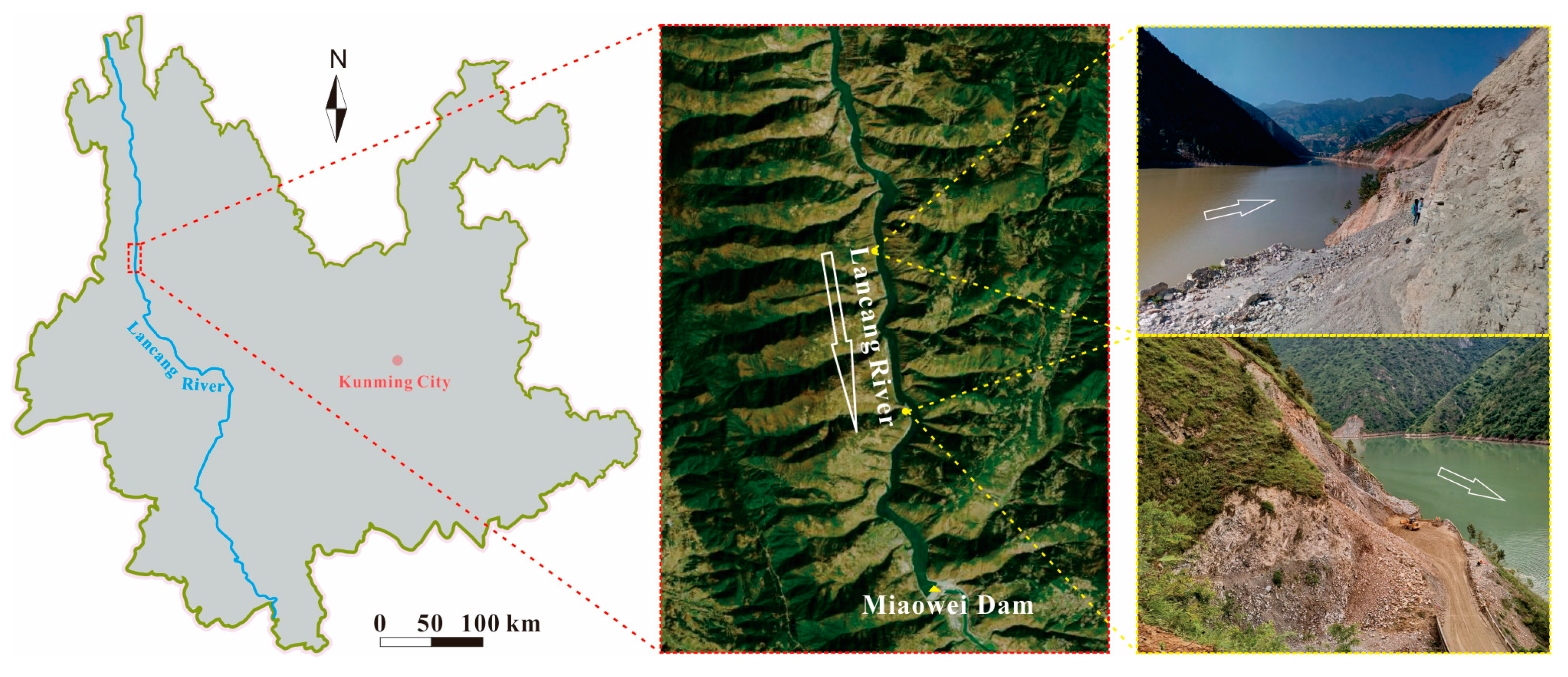
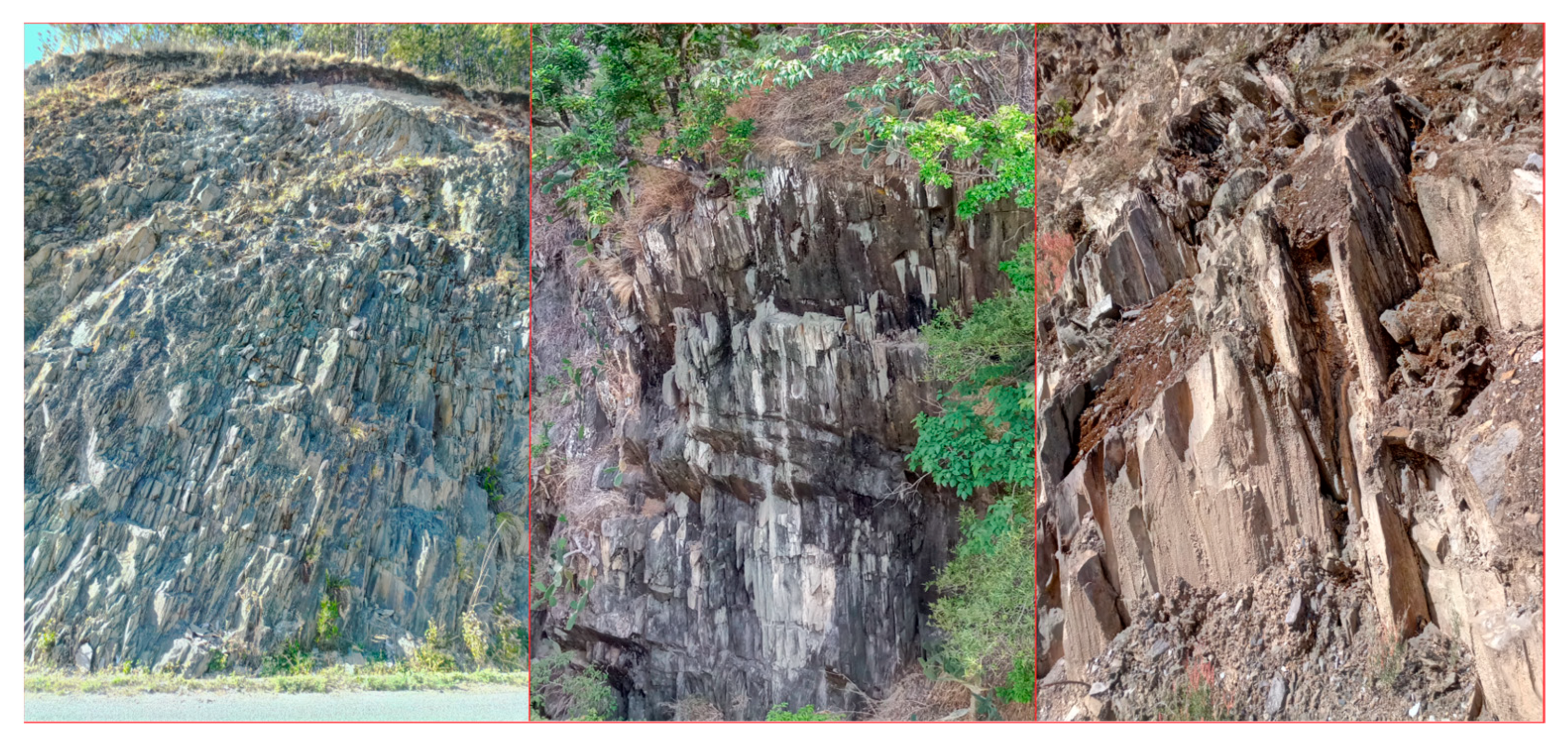
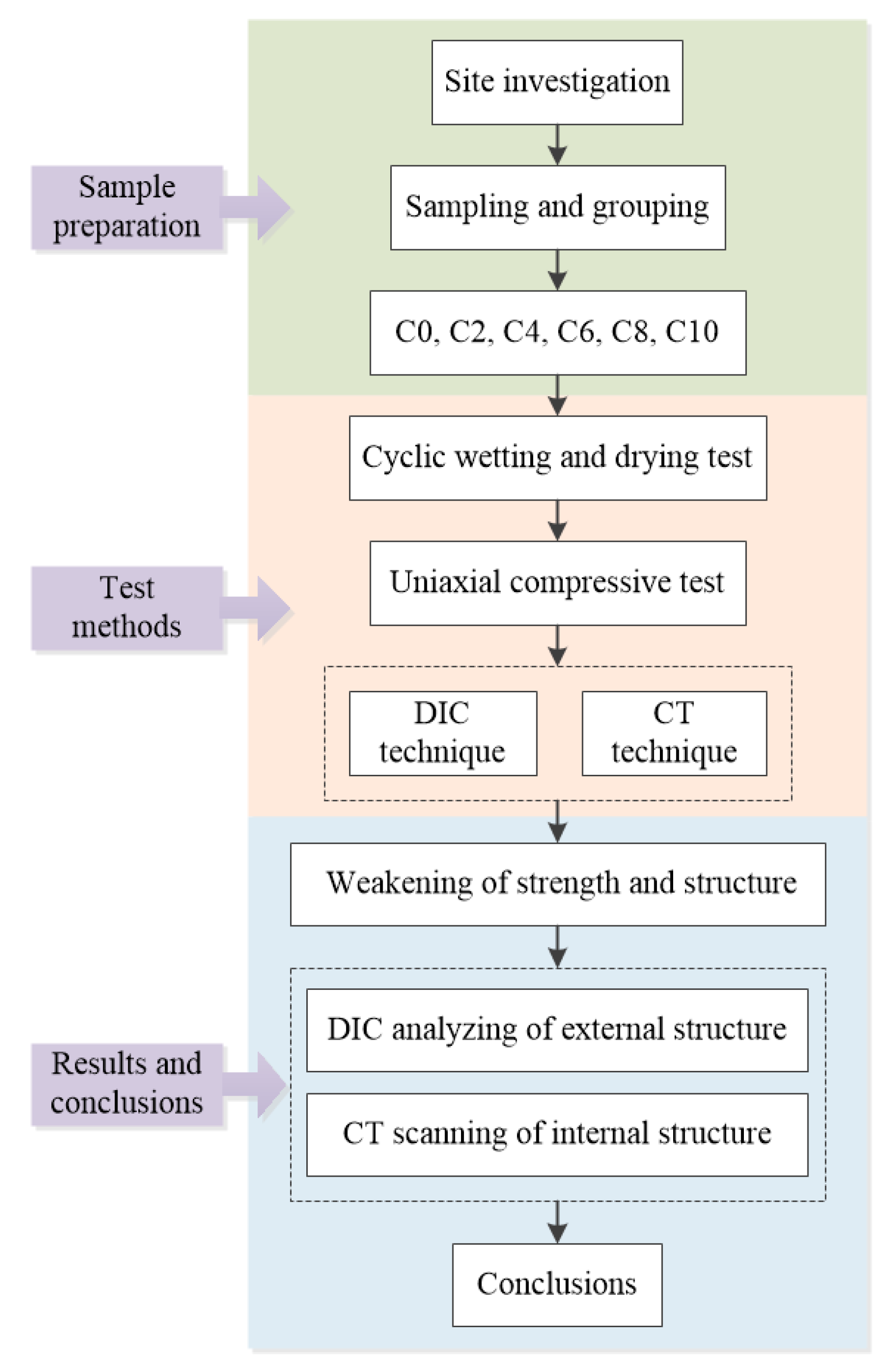

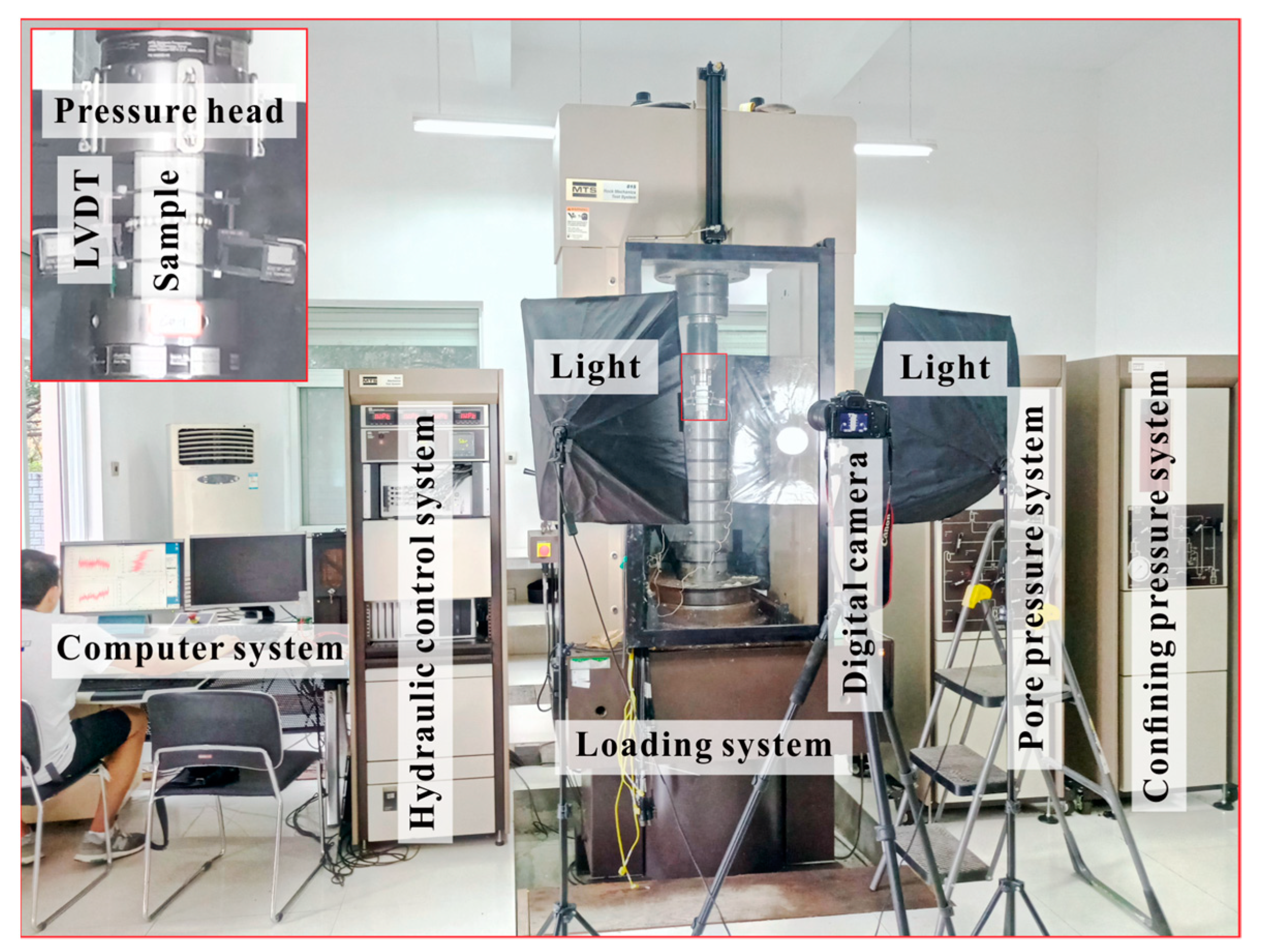
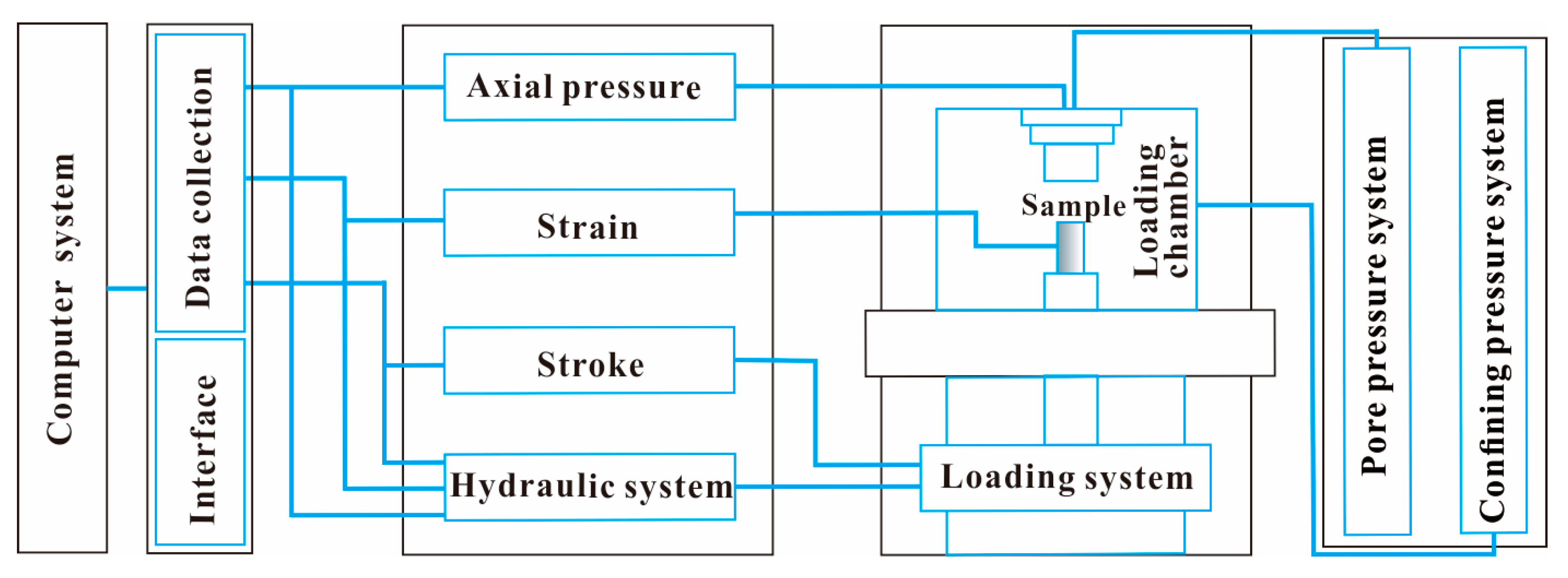
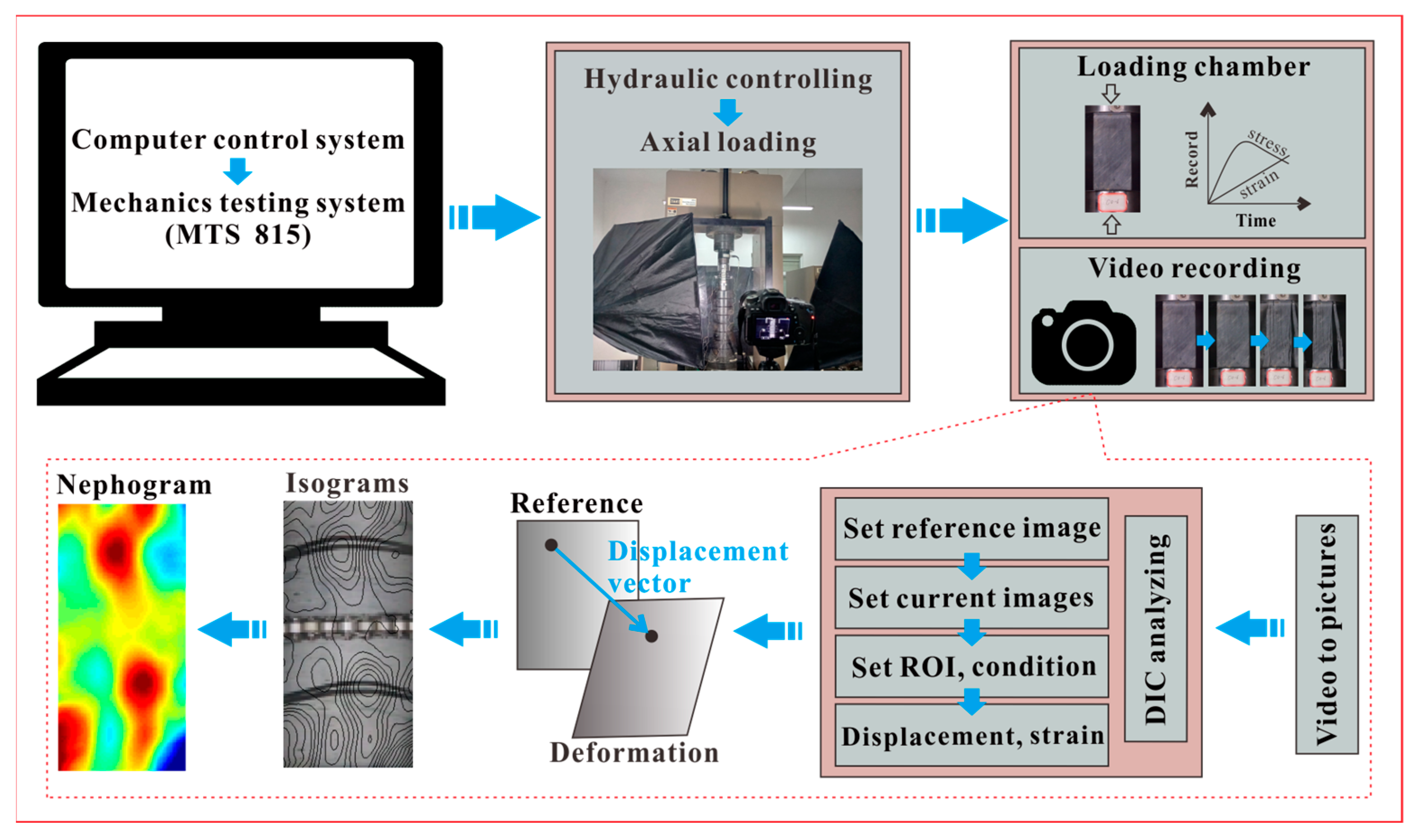

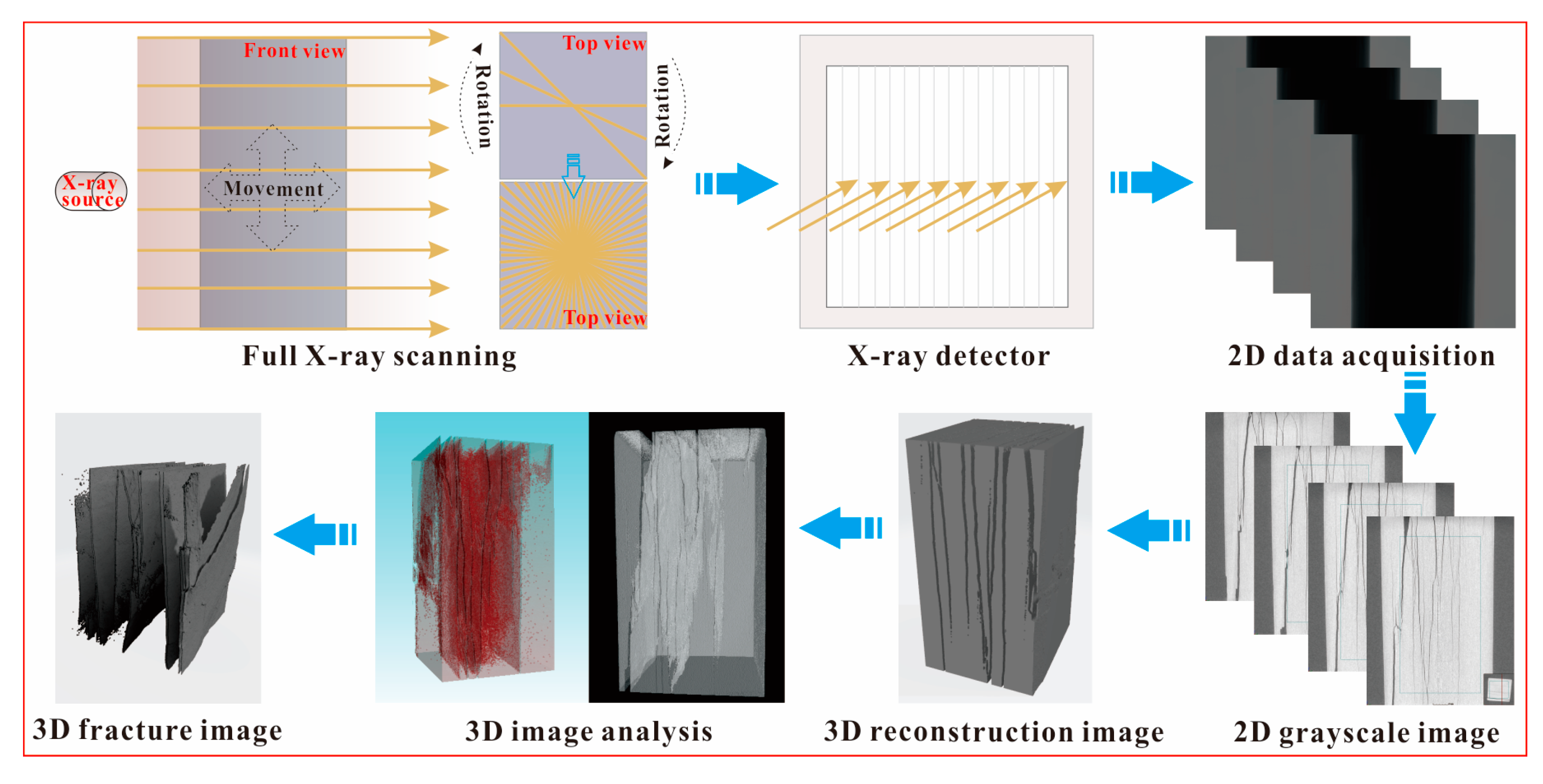

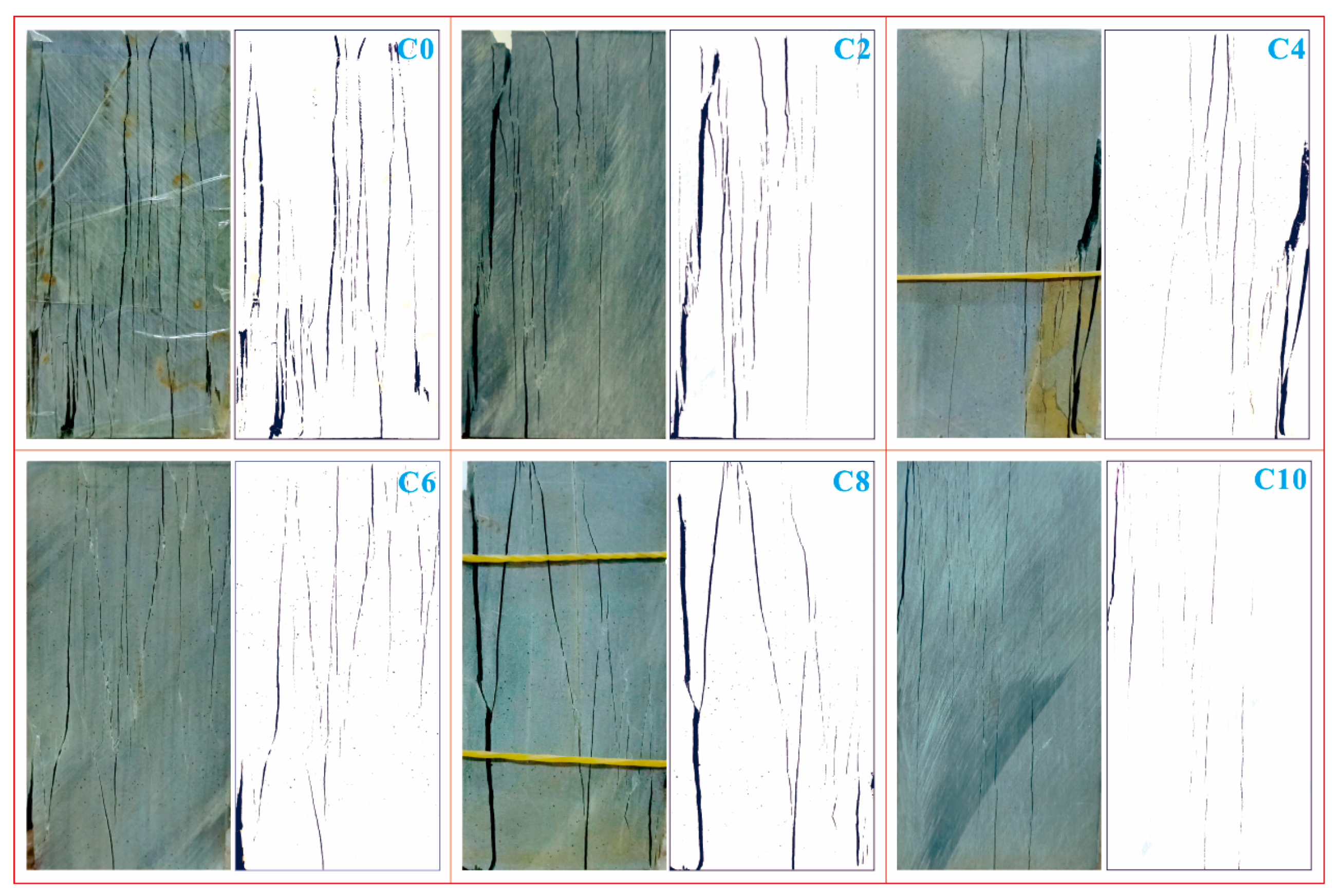
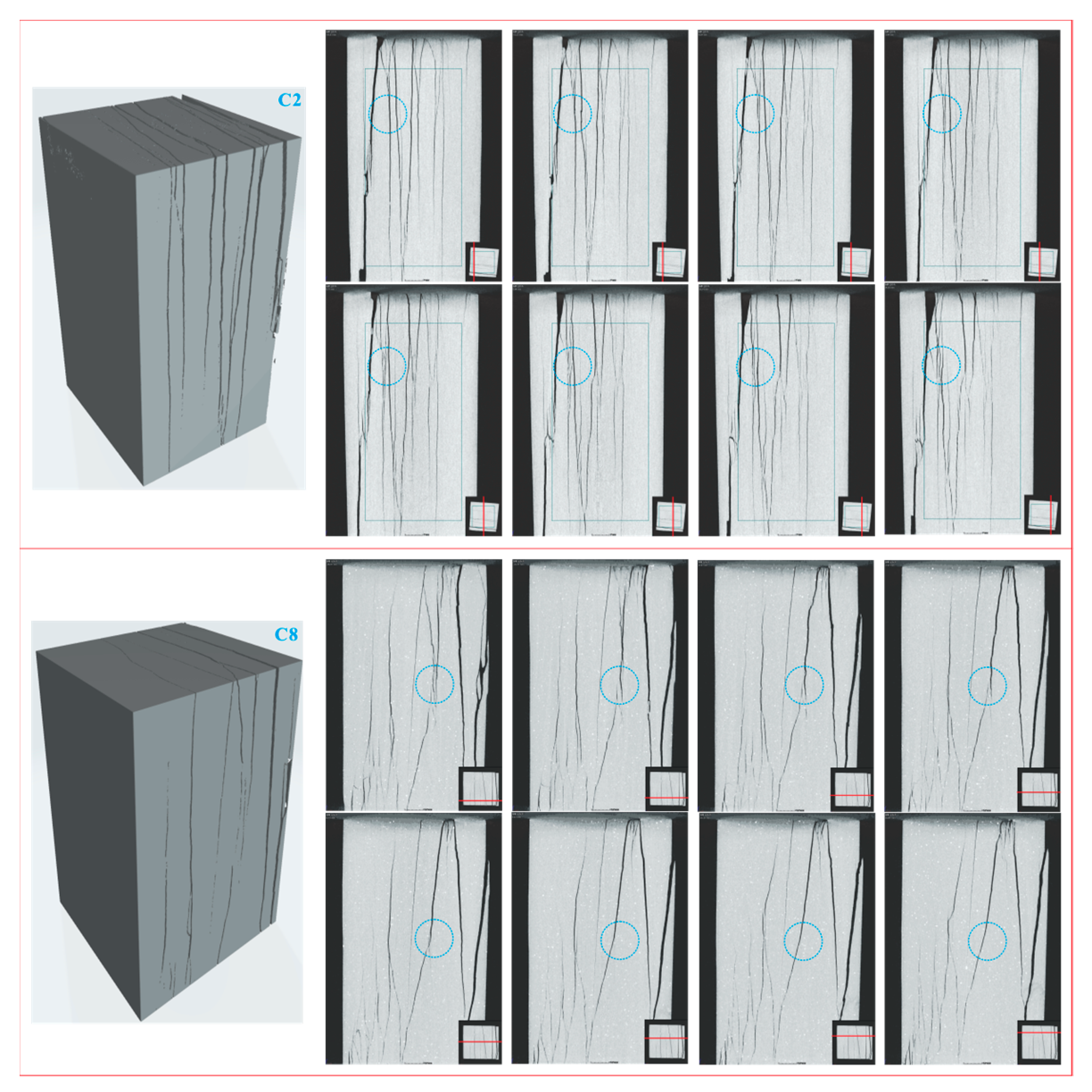
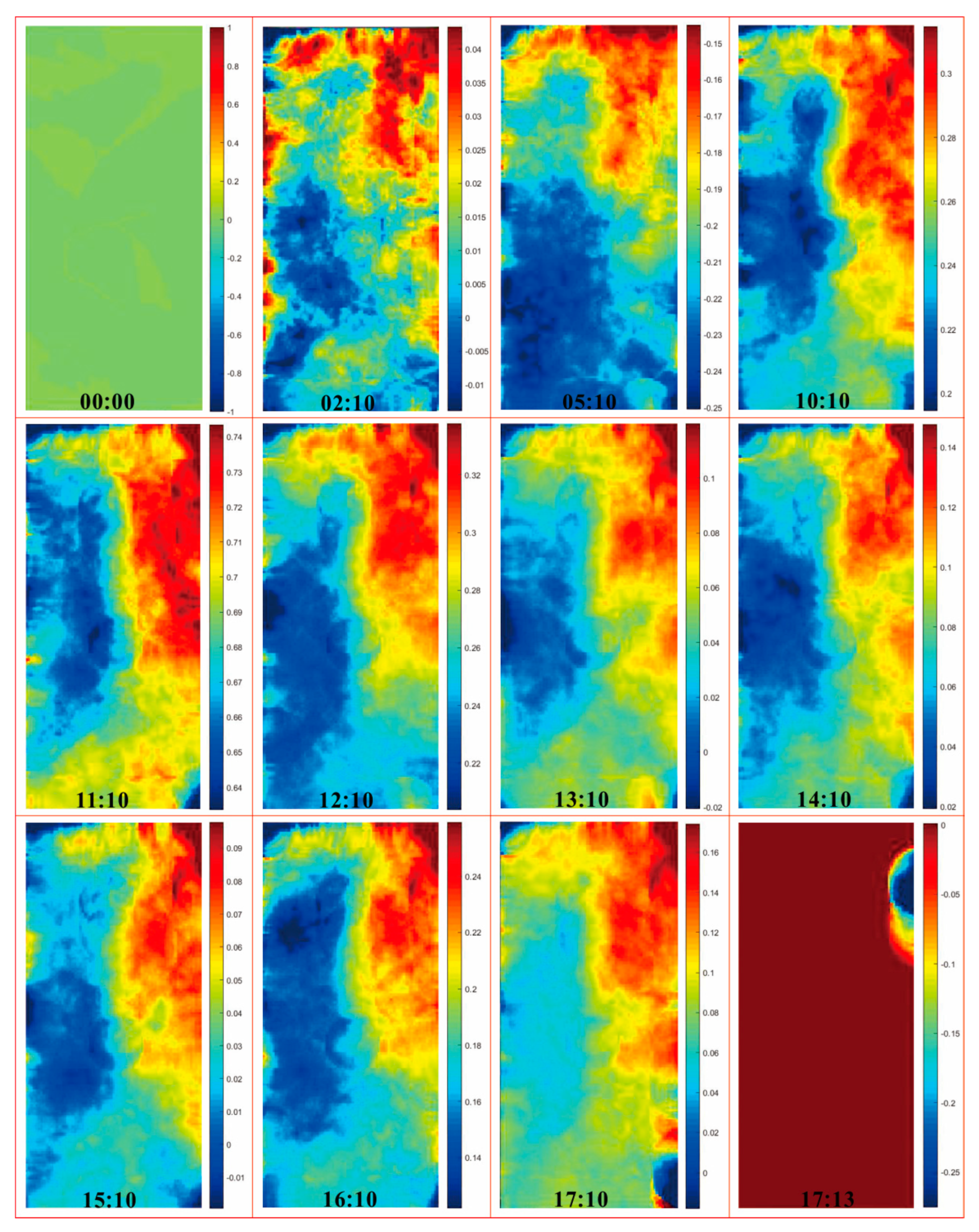
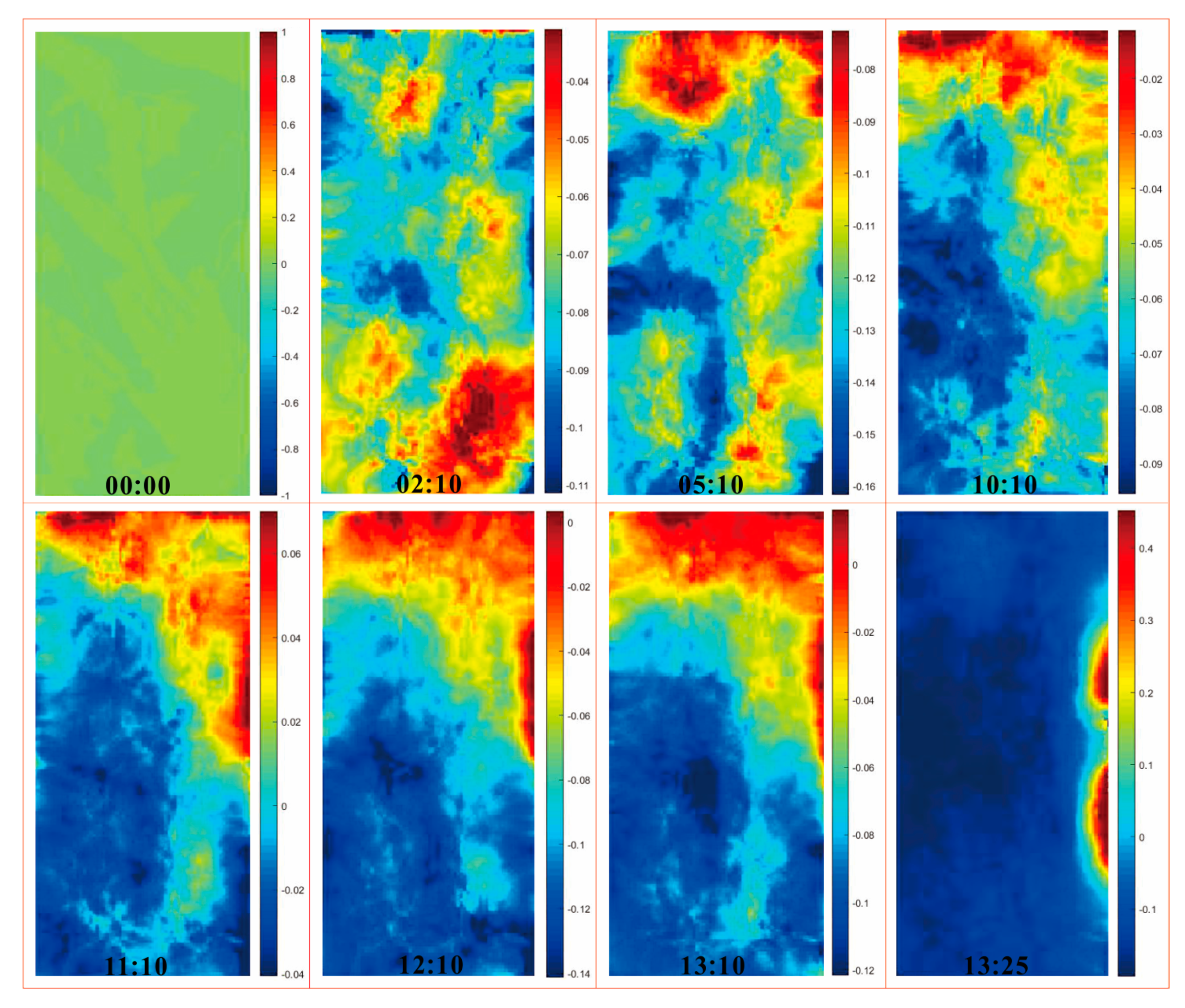
| Treatments | Contents | Particulars |
|---|---|---|
| Wetting | Test site | Geotechnical laboratory |
| Soak solution | Distilled water | |
| Temperature | Room temperature | |
| Duration | 72 h | |
| Drying | Test site | Geotechnical laboratory |
| Heating mode | Electric dry oven | |
| Temperature | 110 °C | |
| Duration | 72 h |
| Aspects | Contents | Particulars |
|---|---|---|
| Operating conditions | Uniaxial compression | −40–60 °C |
| Loading parameters | Max. axial load | 4600 kN |
| Max. pore water pressure | 70 MPa | |
| Servo valve sensitivity | 290 HZ | |
| Data acquisition channels | 10 | |
| Min. sampling time | 50 μs | |
| Sample requirements | Uniaxial compression | 300 mm (Max. diameter) |
| 600 mm (Max. height) |
| Aspects | Contents | Particulars |
|---|---|---|
| Operating conditions | Temperature and Relative humidity (RH) | 10–30 °C, 25–70 RH |
| X-ray parameters | Max. voltage | 240 kV |
| Max. power | 320 W | |
| Min. focal length | 4.5 mm | |
| Detail detectability | <1 μm | |
| Max. voxel resolution | <2 μm | |
| Geometric magnification (3D) | 1.46–100× | |
| Sample manipulator | Number of axes | 5 |
| Rotation | 0–360° | |
| Max. sample weight | 10 kg | |
| Max. sample size | 260 mm × 400 mm (diameter × height) | |
| Axis speed | 0.01–80 mm/s |
Publisher’s Note: MDPI stays neutral with regard to jurisdictional claims in published maps and institutional affiliations. |
© 2021 by the authors. Licensee MDPI, Basel, Switzerland. This article is an open access article distributed under the terms and conditions of the Creative Commons Attribution (CC BY) license (http://creativecommons.org/licenses/by/4.0/).
Share and Cite
Shen, P.; Tang, H.; Zhang, B.; Ning, Y.; Su, X.; Sun, S. Weakening Investigation of Reservoir Rock by Coupled Uniaxial Compression, Computed Tomography and Digital Image Correlation Methods: A Case Study. Sensors 2021, 21, 344. https://doi.org/10.3390/s21020344
Shen P, Tang H, Zhang B, Ning Y, Su X, Sun S. Weakening Investigation of Reservoir Rock by Coupled Uniaxial Compression, Computed Tomography and Digital Image Correlation Methods: A Case Study. Sensors. 2021; 21(2):344. https://doi.org/10.3390/s21020344
Chicago/Turabian StyleShen, Peiwu, Huiming Tang, Bocheng Zhang, Yibing Ning, Xuexue Su, and Sixuan Sun. 2021. "Weakening Investigation of Reservoir Rock by Coupled Uniaxial Compression, Computed Tomography and Digital Image Correlation Methods: A Case Study" Sensors 21, no. 2: 344. https://doi.org/10.3390/s21020344
APA StyleShen, P., Tang, H., Zhang, B., Ning, Y., Su, X., & Sun, S. (2021). Weakening Investigation of Reservoir Rock by Coupled Uniaxial Compression, Computed Tomography and Digital Image Correlation Methods: A Case Study. Sensors, 21(2), 344. https://doi.org/10.3390/s21020344




